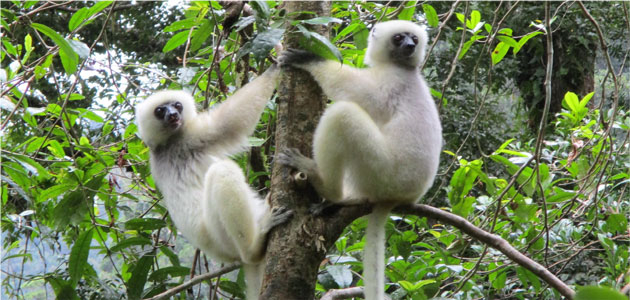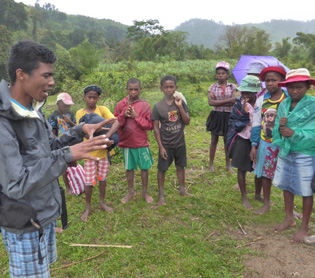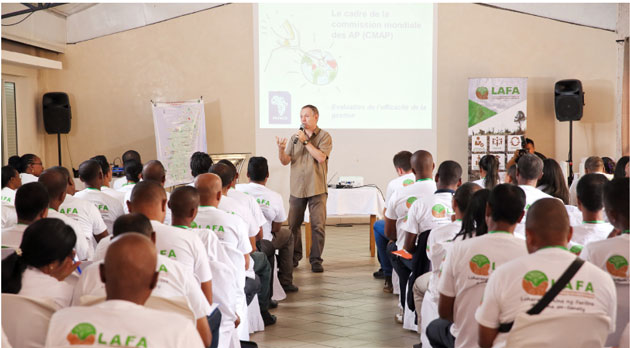Read the web version here
 |
|
|
| PROMISING RESULTS OF SILKY SIFAKA CONSERVATION IN MAKIRA Conservation success for one of the world’s rarest lemurs | ||
Propithecus candidus -known locally as ‘Simpona’ or the Silky Sifaka- is a large lemur characterized by its remarkable long, silky, white fur. One of the world’s rarest mammals, several populations of these magnificent animals are found in Makira Na-tural Park in northeast Madagascar, but the species remains threatened by hunting and habitat loss. WCS has been working to protect this species since 2003. Recent analyses have shown that since 2013 there has been an overall positive trend in the population densities of Silky Sifaka which have |
increased from 82 to 166 individual recordings per surveyed km². The number of groups observed during transect monitoring has increased from 23 to 38, and the average group size has increased from 3.5 to 4.5 individuals/group. Adventurous tourists looking for an authentic forest experience can visit the Simpona Ecolodge in Antsahabe Forest in Makira, and observe two groups of Silky Sifakas up close in their natural habitat. Please come and visit and join us in conserving this critically endangered species! | |
 | ||
| [ Back to top ] | ||
| ENVIRONMENTAL EDUCATION IN MAKIRA NATURAL PARK New educational circuit ‘The Silky Sifaka Trail’ opened for tourists and students | |
The Simpona Ecolodge in the Antsahabe forest in Makira Natural Park not only generates revenues for local communities but also provides an opportunity for local communities to learn about Madagascar’s wildlife. The Silky Sifaka Trail, which was opened around the Ecolodge in late 2017, offers a new opportunity for students and visitors to discover the importance of biodiversity and conservation in Makira. Twelve stations are set up along the trail and serve as observation points. At each station visitors take part in a fun quiz that aims to raise their awareness about existing faunal and floral species as well as conservation issues in Makira Natural Park. Along the 1.8 km circuit, which takes around 1.5h to complete, observations of the famous Silky Sifaka are possible together with many other flora and fauna species. The circuit is open for weekend outings by local communities, visits by groups of students as part of WCS’s environmental education program, and for everyday exploration by the campsite visitors. |
This new design is the result of a successful collaboration between the WCS team and a Swiss volunteer, Ms. Andrea Neuhäuser to whom we offer our sincere thanks!  |
| [ Back to top ] | |
| MANAGEMENT OF MADAGASCAR’S TERRESTRIAL PROTECTED AREAS A national forum of terrestrial protected area professionals is launched in Madagascar | ||
The Lafa Forum is a newly created network of professionals who manage Madagascar’s terrestrial protected areas. The Forum aims to provide a mechanism for exchanges and learning opportunities for protected area managers and thus contribute to increased protection of the country’s biodiversity. The forum was launched during a workshop in November 2017 in Antananarivo. “There are a lot of protected areas in Madagascar but they are located in remote, rural areas. Protected area managers are motivated, but they are isolated, and often lack the tools needed to do their work. In recognition of this problem, a group of partners has come together to create the Lafa forum.”, said Alison Clausen, WCS Regional Director in Madagascar and the Western Indian Ocean during the launch event that was attended by over 100 people. |
The name of the Forum comes from the Malagasy word Lafa, the local name of the Madagascar endemic palm Dypsis Decaryi, and is also abbreviation of a strong message that the network wants to convey: "Loharanon'Aina ny Faritra Arovana an-tanety", meaning that "a terrestrial protected area is a source of life". This initiative is led by WCS in partnership with Fanamby, GiZ, and the Madagascar Biodiversity Fund (FAPBM) with the financial support of The Leona M. and Harry B. Helmsley Charitable Trust. The forum’s website is online now. For more information on the Forum and its activities, please visit www.forum-lafa.org or refer to news and factsheets in https://madagascar.wcs.org or contact wcsmad@wcsmad.org. | |
 | ||
| [ Back to top ] | ||
| WCS AT THE 10TH WIOMSA SYMPOSIUM WCS Madagascar attended the 10th WIOMSA Scientific Symposium in Dar es Salaam, Tanzania, October 30 - November 4, 2017 | |||
The 10th WIOMSA Scientific Symposium was jointly organized by WIOMSA, the Institute of Marine Science (IMS) and the Department of Aquatic Sciences and Fisheries (DASF) both of the University of Dar es Salaam, the Tanzania Fisheries Institute (TAFIRI) and the Nairobi Convention. Three representatives from WCS Madagascar participated in the symposium which included a wide variety of participants from countries across the Western Indian Ocean, ranging from students to managers and scientists and from communities to decision-makers. During the symposium, the WCS team shared their knowledge, experience and the results of our coastal and marine conservation through the presentation of eight poster sessions. Among the |

| ||
| |||
| [ Back to top ] | |||
|
|
Copyright© - 2018 - WCS Madagascar. |



